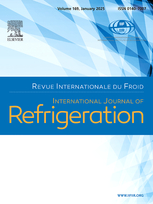
Document IIF
Effets des gaz non condensables dans les appareils domestiques.
The effects of non-condensable gases in domestic appliances.
Auteurs : CECCHINATO L., DELL'EVA M., FORNASIERI E., et al.
Type d'article : Article, Article de la RIF
Résumé
It is well known that the presence of non-condensable gases inside a compression vapour refrigerating circuit introduces an additional thermal resistance at the condenser, which can significantly decrease the energy efficiency of the system. However, this problem so far has been investigated mainly for shell and tube condensers of large capacity and limited information is available on small systems, as is the case for household appliances where the internal volumes are extremely reduced and therefore a very small amount of non-condensable gas has large effect. Moreover, non-condensable gas behaves differently when condensation takes place outside tubes (shell and tube condensers) or inside tubes (condensers of small appliances); in the first case all heat transfer area is wrapped by a gas layer, whereas in the second case non-condensable gas is collected at the end of the tube. The effect of non-condensable gas in this work is experimentally investigated by injecting controlled amounts of air into a refrigerating circuit and by recording the thermal and electric variables during different modes of operation (steady state and cyclic running). The tested refrigerating circuits are part of two appliances on the market, a household refrigerator and a vertical freezer. The presence of non-condensable gas was found to spoil energy efficiency, since it brings about an increase in condensing pressure and a concomitant decrease in evaporating temperature, although larger liquid subcooling partially compensates for the first negative effects: the reason for this behaviour is the clogging action of bubbles of gaseous mixture (air and refrigerant vapour) that enter the capillary tube.
Documents disponibles
Format PDF
Pages : 19-27
Disponible
Prix public
20 €
Prix membre*
Gratuit
* meilleur tarif applicable selon le type d'adhésion (voir le détail des avantages des adhésions individuelles et collectives)
Détails
- Titre original : The effects of non-condensable gases in domestic appliances.
- Identifiant de la fiche : 2006-2955
- Langues : Anglais
- Source : International Journal of Refrigeration - Revue Internationale du Froid - vol. 30 - n. 1
- Date d'édition : 01/2007
Liens
Voir d'autres articles du même numéro (21)
Voir la source
Indexation
-
A propos des processus dans un réfrigérateur do...
- Auteurs : OSOKIN V. V., RZESIK K. A., KUDRIN A. B., et al.
- Date : 2007
- Langues : Russe
- Source : Holodil'na Tehnika i Tehnologiâ - vol. 108 - n. 4
Voir la fiche
-
Optimisation de la longueur des tubes capillair...
- Auteurs : GE Y., YAN Q.
- Date : 05/1996
- Langues : Chinois
- Source : HV & AC - vol. 26 - n. 111
Voir la fiche
-
Problematyka doboru rurki kapilarnej jako eleme...
- Auteurs : BUTRYMOWICZ D., BONCA Z.
- Date : 1997
- Langues : Polonais
- Source : Chlodnictwo - vol. 32 - n. 7
Voir la fiche
-
Problematyka doboru rurki kapilarnej jako eleme...
- Auteurs : BUTRYMOWICZ D., BONCA Z.
- Date : 1997
- Langues : Polonais
- Source : Chlodnictwo - vol. 32 - n. 8
Voir la fiche
-
An experimental study of the performance of a d...
- Auteurs : WON S., JUNG D., RADERMACHER R.
- Date : 07/1994
- Langues : Anglais
- Source : International Journal of Refrigeration - Revue Internationale du Froid - vol. 17 - n. 6
- Formats : PDF
Voir la fiche
